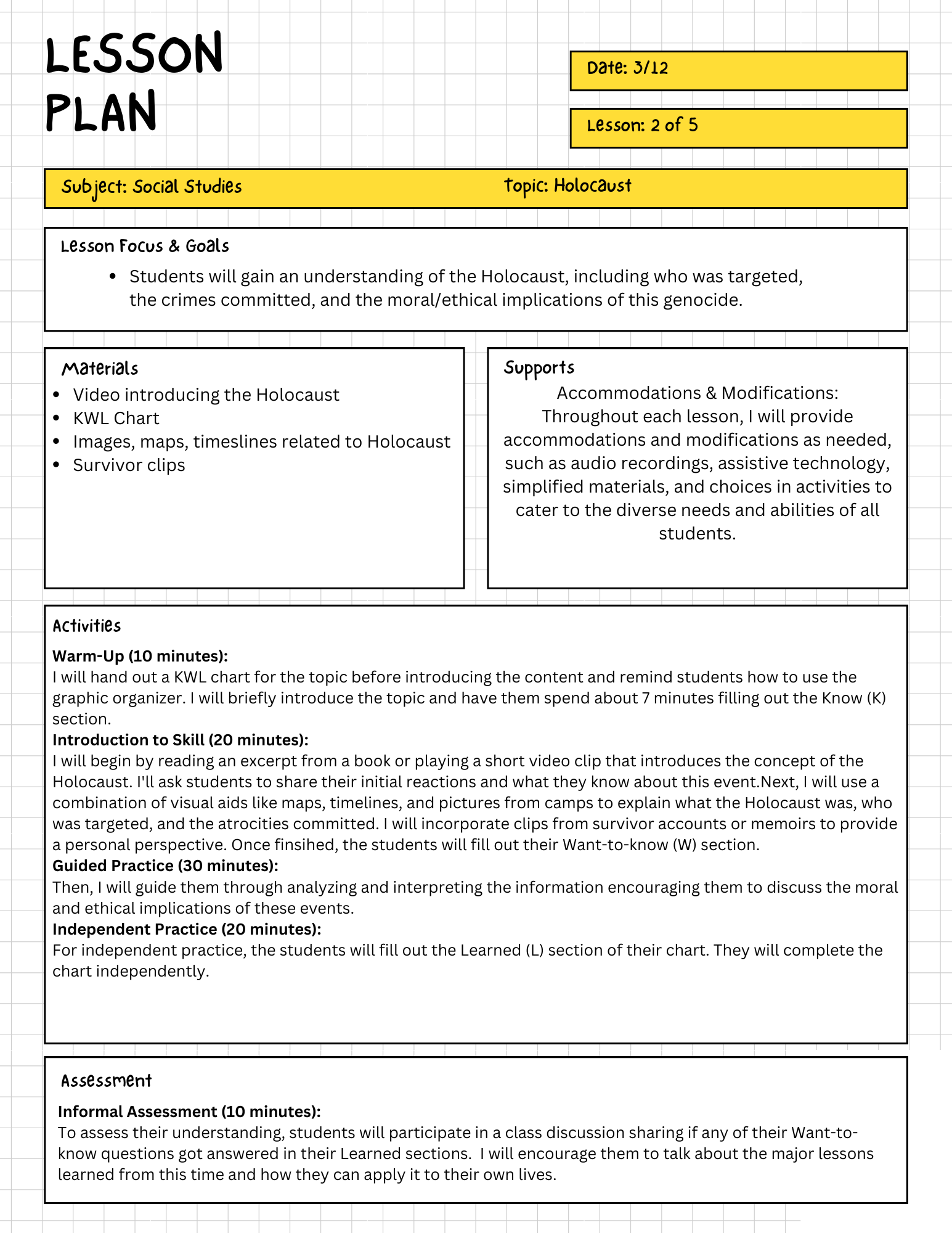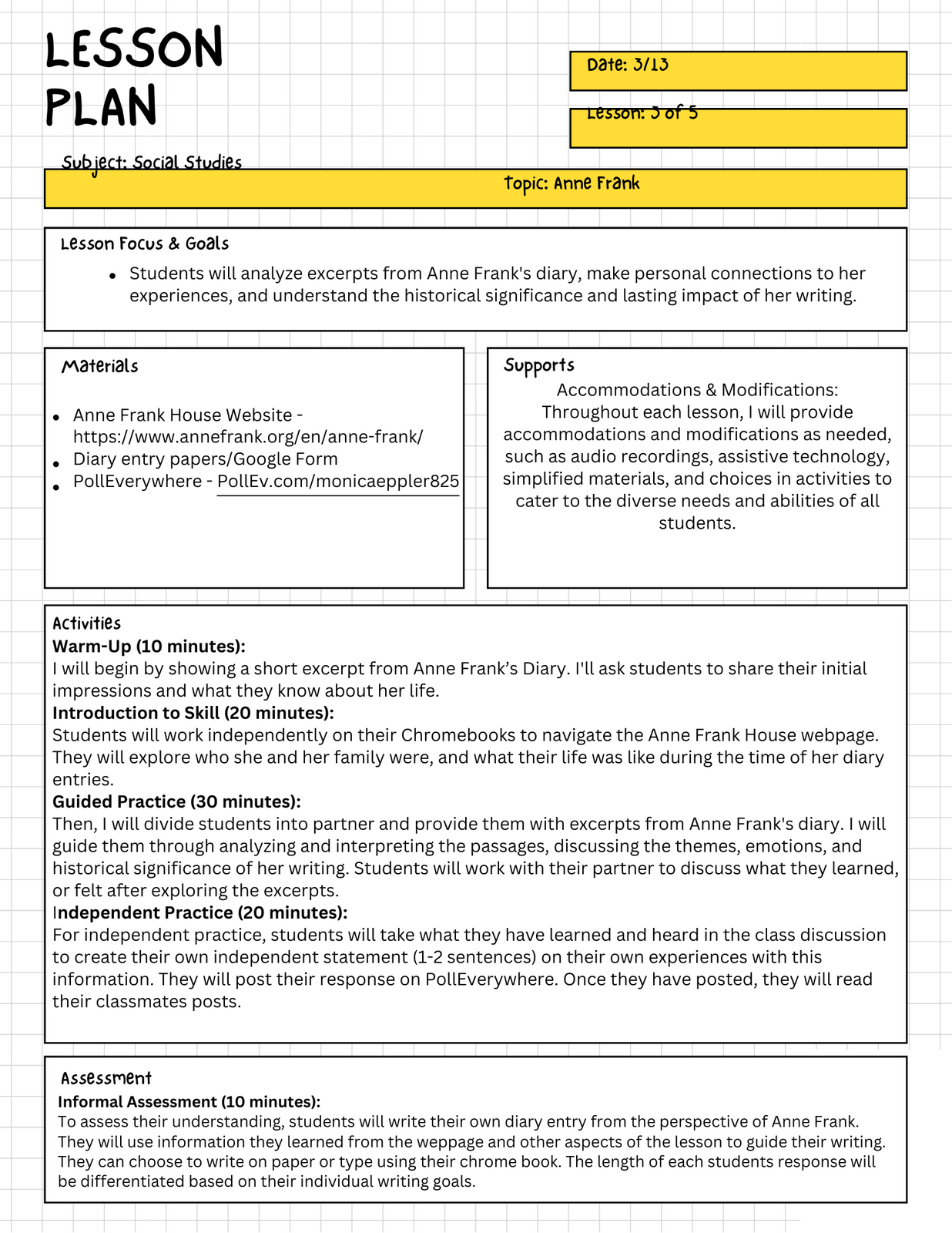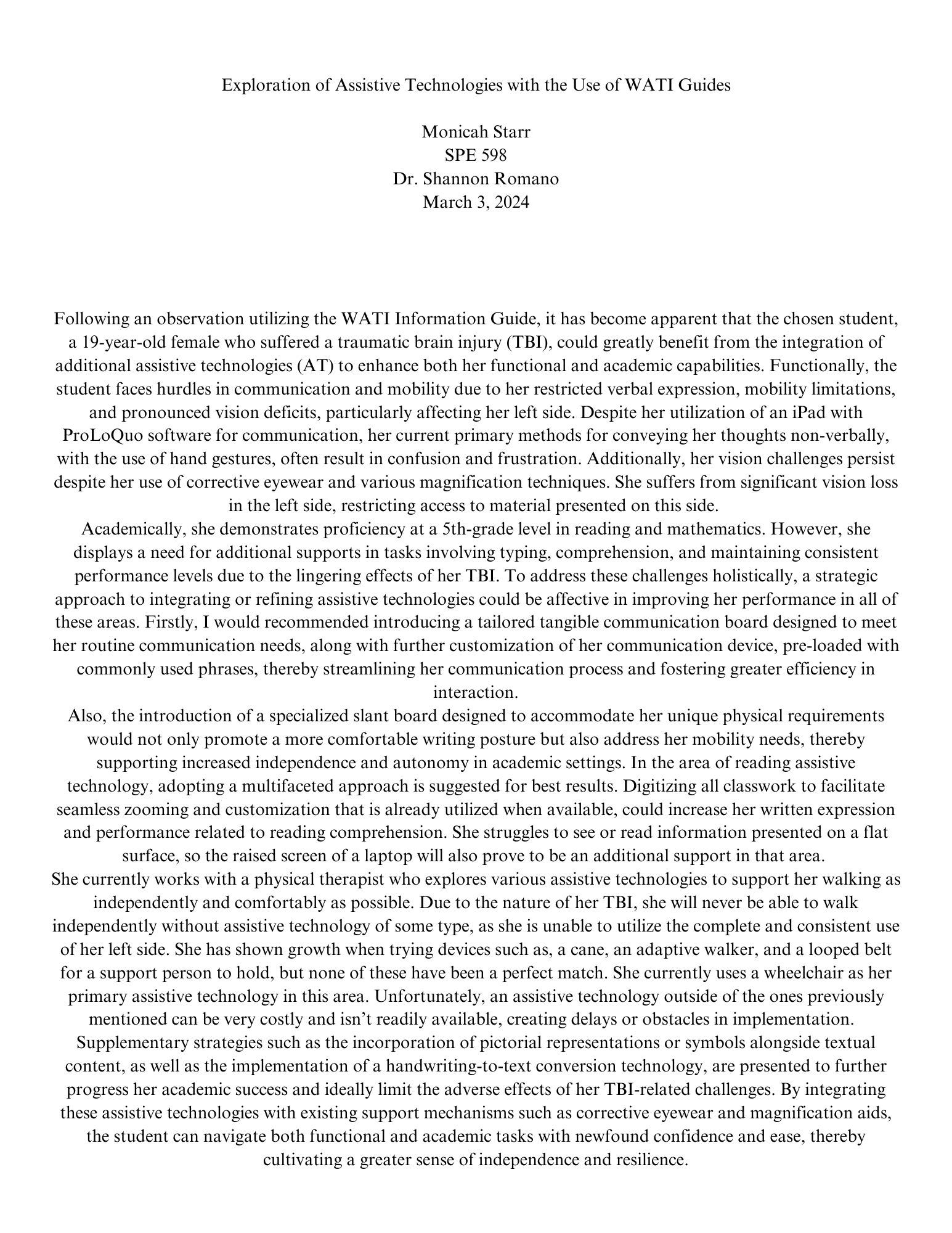Monicah Starr
Final Teaching Portfolio
SPE 588
Sections
- Teaching and Learning
- Diversity
- Content Knowledge
- Instructional Practices
- Profesional Learning
- Teaching Video 1
- Teaching Video 2
Teaching & Learning
- Written Explanation
- Instructional Unit lesson plans
Written Explanation
In the provided instructional unit on World War II and the Holocaust, I demonstrate how I draw upon a thorough understanding of learning and development to positively impact learning and achievement for my students across various school environments. Throughout the unit, I consistently activate students' prior knowledge and provide context through warm-up activities, videos, timelines, and open-ended questions, aligning with Vygotsky's Sociocultural Theory on the role of social interactions and cultural context in cognitive development (McLeod, 2018).
I provide scaffolding and support to help students reach their Zone of Proximal Development (ZPD) (Vygotsky, 1978) by using visual aids, audio recordings, concrete examples, and breaking down complex concepts into manageable chunks. The unit incorporates cooperative learning strategies and encourages peer interactions, facilitating co-construction of knowledge and enhancing engagement (Gillies, 2016), such as partners discussing excerpts from Anne Frank's diary in Lesson 3.
To cater to diverse learner needs and preferences, I incorporate principles of differentiated instruction and Universal Design for Learning (UDL) (CAST, 2018; Tomlinson, 2014), providing accommodations and modifications like audio recordings, assistive technology, simplified materials, and choices in activities. For instance, in Lesson 5, students have a choice board for their summative assessment, allowing them to demonstrate understanding in different ways.
By discussing the moral and ethical implications of the Holocaust and encouraging personal connections, such as students posting their experiences on PollEverywhere in Lesson 3, I aim to create a culturally responsive learning environment that promotes critical thinking and empathy (Ladson-Billings, 1995). The unit also incorporates various formative assessment strategies like informal discussions, quick checks, and written reflections, aligning with embedded formative assessment principles to provide feedback and inform instructional adjustments (Wiliam, 2011).
Through integrating these evidence-based practices of activating prior knowledge, scaffolding, cooperative learning, differentiation, culturally responsive pedagogy, and formative assessment, I demonstrate how I draw upon a comprehensive understanding of learning and development to positively impact student learning and achievement across various school environments.
Click the link to access the artifact:
References:
CAST (2018). Universal Design for Learning Guidelines version 2.2. http://udlguidelines.cast.org
Gillies, R. M. (2016). Cooperative learning: Review of research and practice. Australian Journal of Teacher Education, 41(3), 39-54. https://doi.org/10.14221/ajte.2016v41n3.3
Ladson-Billings, G. (1995). Toward a theory of culturally relevant pedagogy. American Educational Research Journal, 32(3), 465-491. https://doi.org/10.3102/00028312032003465
McLeod, S. A. (2018, August 5). Vygotsky's socio-cultural theory. Simply Psychology. https://www.simplypsychology.org/vygotsky.html
Tomlinson, C. A. (2014). The differentiated classroom: Responding to the needs of all learners (2nd ed.). ASCD.
Vygotsky, L. S. (1978). Mind in society: The development of higher psychological processes. Harvard University Press.
Wiliam, D. (2011). Embedded formative assessment. Solution Tree Press.
Diversity
- Written Explanation
- Lesson Plan
This lesson plan on the Holocaust serves as a powerful example of how to implement culturally responsive practices that recognize and address the needs of all learners. A foundational aspect of culturally responsive pedagogy is incorporating diverse narratives, primary sources, and firsthand accounts into the curriculum, especially when teaching about oppression, marginalization, and human rights violations (Misco, 2018). By intentionally utilizing survivor accounts, memoirs, and personal perspectives throughout the lesson, students gain a multifaceted understanding of the Holocaust that centers the lived experiences of those most impacted. This approach validates and amplifies voices and stories that have historically been marginalized, cultivating greater empathy, critical consciousness, and humanity.
Also, Waitoller and Kozleski (2013) emphasize the ethical imperative for educators to engage in practices that authentically validate the diverse backgrounds, cultures, abilities, and unique needs represented in their classrooms. Aligned with this research, the lesson plan explicitly states accommodations and modifications will be seamlessly integrated to ensure an inclusive, equitable learning experience. Utilizing assistive technologies, audio recordings, simplified materials tailored to individual needs, and providing choice in activities demonstrates a culturally responsive commitment to differentiation and Universal Design for Learning principles. This proactive approach to accessibility avoids marginalization and creates an environment where every student feels valued, supported, and empowered to engage with the content meaningfully.
The use of audio recordings and assistive technologies supports students with disabilities or diverse learning needs, ensuring the content is accessible. Simplified materials account for variabilities in reading levels and language proficiencies. Providing choices in activities allows student voice while differentiating based on interests and strengths. These accommodations and modifications are part of the lesson design aligning with the principles of Universal Design for Learning (UDL).
By weaving diverse perspectives through primary sources, highlighting stories of the marginalized, and prioritizing accommodations and modifications to meet all students' needs, this lesson embodies culturally responsive lesson planning within my teaching practice. It not only deepens students' understanding of the Holocaust but also deepens critical skills like empathy, social awareness, and civic responsibility - impacting learning holistically. Ultimately, this culturally responsive approach enriches the educational experience, and promotes equity and inclusion.

References
Misco, T. (2018). Culturally responsive curriculum and pedagogy in the Commonwealth of the Northern Mariana Islands. International Journal of Multicultural Education, 20(2), 81-100. https://doi.org/10.18251/ijme.v20i2.1592
Waitoller, F. R., & Kozleski, E. B. (2013). Working in boundary practices: Identity development and learning in partnerships for inclusive education. Teaching and Teacher Education, 31, 35-45. https://doi.org/10.1016/j.tate.2012.11.006
Content Knowledge
- Written Explanation
- Link to Intervention Lesson Plan
In this lesson plan, I exhibit mastery of the discipline of special education with consideration to applied behavior analysis by designing an evidence-based intervention using the research-supported strategy of task analysis. The lesson plan highlights how task analysis has been shown to effectively address target behaviors in students with ASD "regardless of cognitive level and/or expressive communicative abilities" (Franzone, 2009). By determining the instructional choices based on this evidence, I demonstrate knowledge of informed practices from the field.
The use of a visual task analysis chart exemplifies leveraging technology as an instructional support to enhance student learning. Visual supports have been widely established as a best practice when teaching students with ASD to promote comprehension of multi-step routines and procedures. Incorporating this visual component capitalizes on the technological affordances of clearly depicting each step of the desired transition routine.
Moreover, the systematic prompting system, establishment of a consistent setting, and plans for continuous data collection procedures reflect my content knowledge of the principles of applied behavior analysis. These are evidence-based methods for effectively shaping behavioral skills through reinforcement strategies tailored for learners with ASD.
The measurable objectives focused on self-reflection, goal-setting using the SMART framework, and ultimately demonstrating mastery of the independent transition routine illustrate my grasp of cognitive and metacognitive strategies to facilitate self-regulated learning. Promoting skills like self-awareness, self-monitoring, and self-advocacy are recognized as critical for the long-term success of students with disabilities.
By synthesizing research from multiple disciplines - special education, applied behavior analysis, cognitive psychology - into a cohesive lesson plan, I demonstrate broad content knowledge. This allows me to design high-quality, individualized intervention with principles of universal design for learning and student-centered pedagogy.
Through the thoughtful integration of assistive technology visuals, structured routines, research-based strategies, and a focus on self-determination, this lesson plan demonstrates my mastery of disciplinary knowledge and its purposeful application to create enriching, impactful learning experiences tailored for diverse student needs.
Click the link to access the artifact:
Resources
Franzone, E. (2009). Overview of task analysis. National Professional Development Center on Autism Spectrum Disorders, Waisman Center, University of Wisconsin. https://autismpdc.fpg.unc.edu/sites/autismpdc.fpg.unc.edu/files/TaskAnalysis_Steps_0.pdf
Instructional Practice
- Written Explanation
- Lesson Plan
Focusing on teaching about Anne Frank and her diary, I researched and designed my instructional approach to implement informed strategies that support learner progress through multiple continuous informal assessments towards each student's individual learning goals.
Before the lesson, I thoroughly explored various resources and methods specifically tailored to teaching this personal narrative within the historical context of the Holocaust. Research highlights the importance of using primary sources and personal accounts in Holocaust education to foster empathy and deeper understanding (Lindquist, 2011; Totten, 2002). I leveraged insights from literacy experts who recommend analyzing literary devices, themes, and emotional perspectives when teaching narrative texts (Beers & Probst, 2017; Gallagher, 2004).
During guided practice, I divided students into small collaborative groups, a technique shown to enhance critical thinking and interpersonal skills (Gokhale, 1995; Tanner et al., 2003). Students analyzed diary excerpts using strategies from literature and history, an interdisciplinary approach advocated for deeper learning (Boix Mansilla & Dawes Duraising, 2007; Drake & Burns, 2004). With technology integration, students could access multimedia resources aligning with principles of multiliteracies pedagogy (New London Group, 1996; Cope & Kalantzis, 2009).
Independent practice built on findings that personal choice enhances motivation and learning (Patall et al., 2010; Stefanou et al., 2004). Assignments like reflective writing and research aligned with recognized ways to extend text-based learning (Applebee & Langer, 2011; Graham & Perin, 2007).
Continuous formative assessment through observation, discussions, and work samples allowed me to adapt instruction per research on effective feedback practices (Black & Wiliam, 2009; Hattie & Timperley, 2007). This individualized, responsive teaching approach reflects learner-centered principles (McCombs & Whisler, 1997; Weimer, 2002).
By implementing research-supported strategies across disciplines, ongoing assessments, and tailored instruction, I aimed to create an immersive experience helping students understand Anne Frank's story, build empathy, and connect individual experiences to the broader World War II context.

References
Gokhale, A. A. (1995). Collaborative learning enhances critical thinking. Journal of Technology Education, 7(1). https://doi.org/10.21061/jte.v7i1.a.2
Graham, S., & Perin, D. (2007). Writing next: Effective strategies to improve writing of adolescents in middle and high schools – A report to Carnegie Corporation of New York. Alliance for Excellent Education.
Hattie, J., & Timperley, H. (2007). The power of feedback. Review of Educational Research, 77(1), 81-112. https://doi.org/10.3102/003465430298487
Lindquist, D. H. (2011). Instructional approaches and teaching resources for use with personal narratives of the Holocaust. Social Education, 75(6), 344-347.
Patall, E. A., Cooper, H., & Robinson, J. C. (2010). The effects of choice on intrinsic motivation and related outcomes: A meta-analysis of research findings. Psychological Bulletin, 134(2), 270-300. https://doi.org/10.1037/0033-2909.134.2.270
Totten, S. (2002). Diminishing the complexity of the Holocaust: Applying psychoanalytic principles in teaching Holocaust literature. In S. Totten (Ed.), Diminishing the complexity of the Holocaust (pp. 141-146). Simon Wiesenthal Center Annual, Vol. 19. Vallentine Mitchell.
Professional Learning
- Written Explanation
- Assignment Reflection for SPE 598
In the assignment to explore the use of Assistive Technology using the WATI Guide, I demonstrate how I design, implement, and evaluate professional and ethical practices by applying coursework on assistive technology in an educational setting and critically reflecting on practices through the lens of educational theory. The assignment outlines the process of designing an assistive technology plan for a 19-year-old student with a traumatic brain injury (TBI) based on the WATI Information Guide observation. This aligns with coursework on conducting AT assessments, evaluating student needs, and identifying appropriate AT solutions.
To address the student's needs comprehensively, I proposed a strategic implementation plan integrating multiple assistive technologies, directly applying principles and strategies from coursework on AT implementation for students with physical and cognitive disabilities. This included introducing a tailored communication board, customizing her existing communication device, providing a specialized slant board for writing posture and mobility support, digitizing classwork for enhanced reading accessibility, exploring handwriting-to-text conversion technology, and incorporating pictorial representations alongside text.
Throughout the assignment, I critically evaluated the student's current AT use and identified areas for improvement through the lens of educational theory and best practices. For instance, I recognized the limitations of her existing communication methods and the need for more efficient, customized solutions aligned with augmentative and alternative communication (AAC) theory. I also acknowledged the challenges posed by her vision and mobility deficits, necessitating a multimodal approach combining low-tech and high-tech solutions grounded in universal design for learning (UDL) frameworks.
The assignment emphasizes ethical practices centered on promoting the student's independence, autonomy, and full participation in academic and functional tasks. The recommendation for a specialized slant board aims to "support increased independence and autonomy in academic settings." Moreover, the overall goal of integrating various AT solutions is to help the student "navigate both functional and academic tasks with newfound confidence and ease, thereby cultivating a greater sense of independence and resilience." These practices align with ethical principles of empowerment, self-determination, and inclusion for individuals with disabilities. By designing an AT plan based on a structured observation process, proposing specific implementations rooted in coursework principles, evaluating current practices through educational theory lenses, and prioritizing ethical considerations, this assignment demonstrates my professional learning in applying AT knowledge to support students with disabilities in educational settings.

lesson video #1
In this video I am teaching lesson 2 of the Instructional Unit. I am guiding students through answering the ‘Know’ and ‘Want to know’ sections of a KWL chart.

Lesson Video #2
In this video I am teaching lesson 3 of the Instructional Unit. I am guiding students through navigating technology resources to explore the topic and reflect on their thoughts using PollEV.
